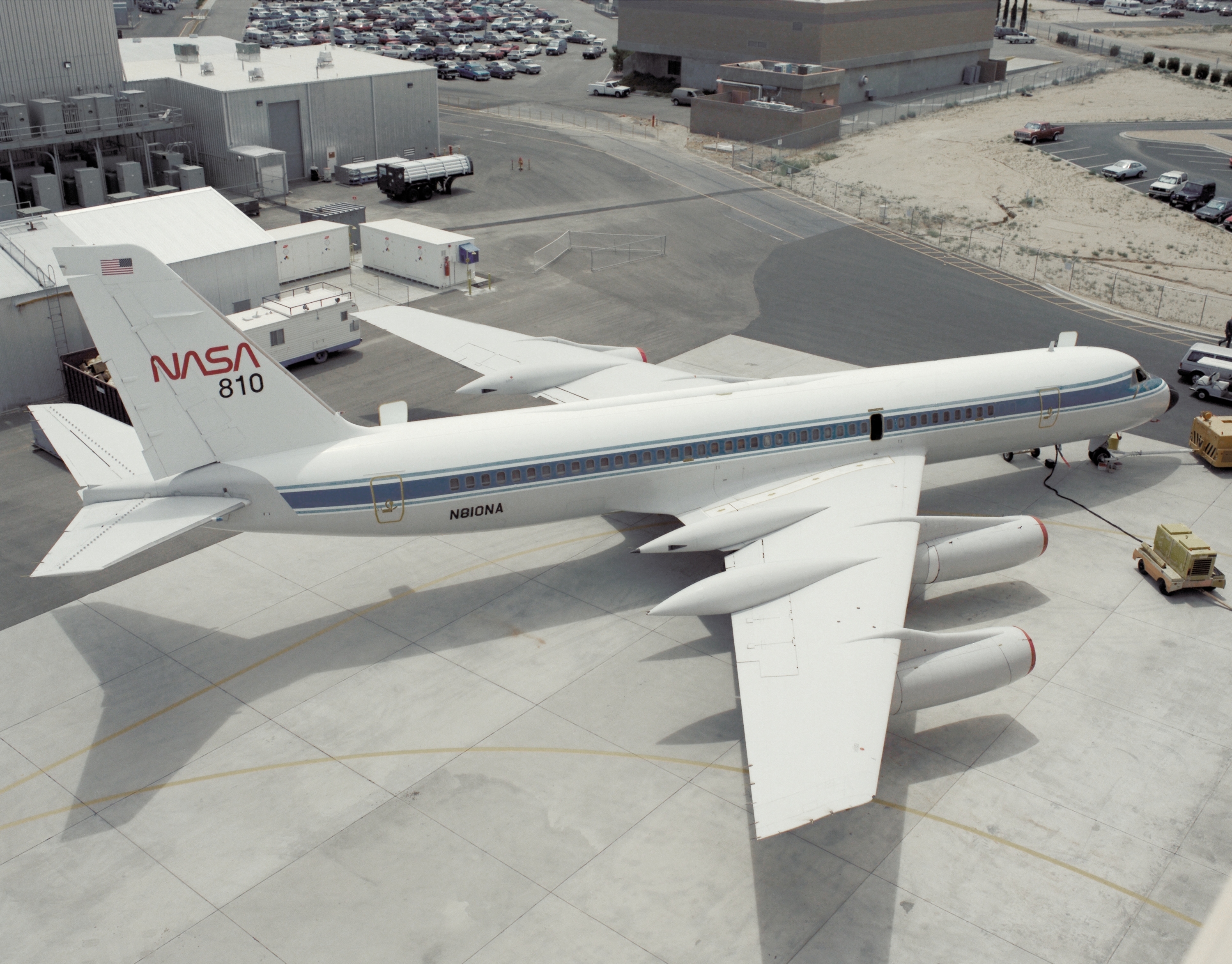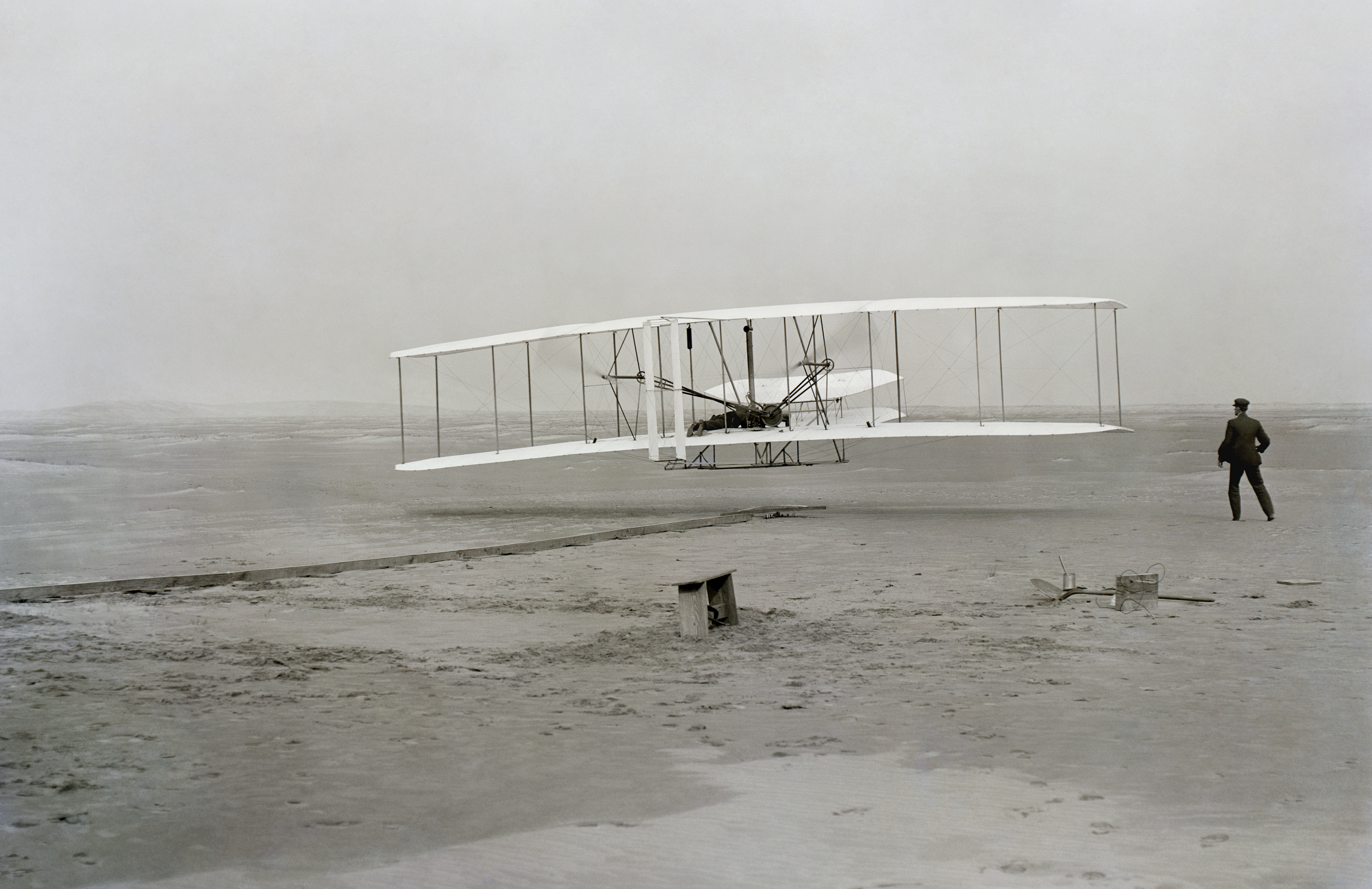|
Fineness Ratio
In naval architecture and aerospace engineering, the fineness ratio is the ratio of the length of a body to its maximum width. Shapes that are short and wide have a low fineness ratio, those that are long and narrow have high fineness ratios. Aircraft that spend time at supersonic speeds, e.g. the Concorde, generally have high fineness ratios. At speeds below critical mach, one of the primary forms of drag is skin friction. As the name implies, this is drag caused by the interaction of the airflow with the aircraft's skin. To minimize this drag, the aircraft should be designed to minimize the exposed skin area, or "wetted surface". One solution to this problem is constructing an "egg shaped" fuselage, for example as used on the home-built Questair Venture. Theoretical ideal fineness ratios in subsonic aircraft fuselages are typically found at about 6:1, however this may be compromised by other design considerations such as seating or freight size requirements. Because a higher ... [...More Info...] [...Related Items...] OR: [Wikipedia] [Google] [Baidu] |
Concorde On Bristol
Concorde () is a retired Anglo-French supersonic airliner jointly developed and manufactured by Sud Aviation and the British Aircraft Corporation (BAC). Studies started in 1954, and France and the United Kingdom signed a treaty establishing the development project on 29 November 1962, as the programme cost was estimated at £70 million (£ in ). Construction of the six prototypes began in February 1965, and the first flight took off from Toulouse on 2 March 1969. The market was predicted for 350 aircraft, and the manufacturers received up to 100 option orders from many major airlines. On 9 October 1975, it received its French certificate of airworthiness, and from the UK CAA on 5 December. Concorde is a tailless aircraft design with a narrow fuselage permitting four-abreast seating for 92 to 128 passengers, an ogival delta wing, and a droop nose for landing visibility. It is powered by four Rolls-Royce/Snecma Olympus 593 turbojets with variable engine intake ra ... [...More Info...] [...Related Items...] OR: [Wikipedia] [Google] [Baidu] |
Wave Drag
In aeronautics, wave drag is a component of the aerodynamic drag In fluid dynamics, drag, sometimes referred to as fluid resistance, is a force acting opposite to the direction of motion of any object moving with respect to a surrounding fluid. This can exist between two fluid layers, two solid surfaces, or b ... on aircraft wings and fuselage, propeller blade tips and Shell (projectile), projectiles moving at transonic and supersonic speeds, due to the presence of shock waves. Wave drag is independent of viscous effects,Clancy, L.J. (1975), ''Aerodynamics'', Section 11.7 and tends to present itself as a sudden and dramatic increase in drag as the vehicle increases speed to the critical Mach number. It is the sudden and dramatic rise of wave drag that leads to the concept of a sound barrier. Overview Wave drag is a component of pressure drag due to compressibility effects. It is caused by the formation of shock waves around a body. Shock waves create a considerable amount ... [...More Info...] [...Related Items...] OR: [Wikipedia] [Google] [Baidu] |
Aerospace Engineering
Aerospace engineering is the primary field of engineering concerned with the development of aircraft and spacecraft. It has two major and overlapping branches: aeronautical engineering and astronautical engineering. Avionics engineering is similar, but deals with the electronics side of aerospace engineering. "Aeronautical engineering" was the original term for the field. As flight technology advanced to include vehicles operating in outer space, the broader term "aerospace engineering" has come into use. Aerospace engineering, particularly the astronautics branch, is often colloquially referred to as "rocket science". Overview Flight vehicles are subjected to demanding conditions such as those caused by changes in atmospheric pressure and temperature, with structural loads applied upon vehicle components. Consequently, they are usually the products of various technological and engineering disciplines including aerodynamics, air propulsion, avionics, materials science, st ... [...More Info...] [...Related Items...] OR: [Wikipedia] [Google] [Baidu] |
Stability Augmentation System
An autopilot is a system used to control the path of a vehicle without requiring constant manual control by a human operator. Autopilots do not replace human operators. Instead, the autopilot assists the operator's control of the vehicle, allowing the operator to focus on broader aspects of operations (for example, monitoring the trajectory, weather and on-board systems). When present, an autopilot is often used in conjunction with an autothrottle, a system for controlling the power delivered by the engines. An autopilot system is sometimes colloquially referred to as ''"George"'' (e.g. ''"we'll let George fly for a while"; "George is flying the plane now".''). The etymology of the nickname is unclear: some claim it is a reference to American inventor George De Beeson (1897–1965), who patented an autopilot in the 1930s, while others claim that Royal Air Force pilots coined the term during World War II to symbolize that their aircraft technically belonged to King George VI. ... [...More Info...] [...Related Items...] OR: [Wikipedia] [Google] [Baidu] |
Center Of Mass
In physics, the center of mass of a distribution of mass in space (sometimes referred to as the barycenter or balance point) is the unique point at any given time where the weight function, weighted relative position (vector), position of the distributed mass sums to zero. For a rigid body containing its center of mass, this is the point to which a force may be applied to cause a linear acceleration without an angular acceleration. Calculations in mechanics are often simplified when formulated with respect to the center of mass. It is a hypothetical point where the entire mass of an object may be assumed to be concentrated to visualise its motion. In other words, the center of mass is the particle equivalent of a given object for application of Newton's laws of motion. In the case of a single rigid body, the center of mass is fixed in relation to the body, and if the body has uniform density, it will be located at the centroid. The center of mass may be located outside the Phys ... [...More Info...] [...Related Items...] OR: [Wikipedia] [Google] [Baidu] |
Inertial Coupling
In classical physics and special relativity, an inertial frame of reference (also called an inertial space or a Galilean reference frame) is a frame of reference in which objects exhibit inertia: they remain at rest or in uniform motion relative to the frame until acted upon by external forces. In such a frame, the laws of nature can be observed without the need to correct for acceleration. All frames of reference with zero acceleration are in a state of constant rectilinear motion (straight-line motion) with respect to one another. In such a frame, an object with zero net force acting on it, is perceived to move with a constant velocity, or, equivalently, Newton's first law of motion holds. Such frames are known as inertial. Some physicists, like Isaac Newton, originally thought that one of these frames was absolute — the one approximated by the fixed stars. However, this is not required for the definition, and it is now known that those stars are in fact moving, relative to o ... [...More Info...] [...Related Items...] OR: [Wikipedia] [Google] [Baidu] |
Rocket Nozzle
A rocket engine nozzle is a propelling nozzle (usually of the de Laval type) used in a rocket engine to expand and accelerate combustion products to high supersonic velocities. Simply: propellants pressurized by either pumps or high pressure ullage gas to anywhere between two and several hundred atmospheres are injected into a combustion chamber to burn, and the combustion chamber leads into a nozzle which converts the energy contained in high pressure, high temperature combustion products into kinetic energy by accelerating the gas to high velocity and near-ambient pressure. History Simple bell-shaped nozzles were developed in the 1500s. The de Laval nozzle was originally developed in the 19th century by Gustaf de Laval for use in steam turbines. It was first used in an early rocket engine developed by Robert Goddard, one of the fathers of modern rocketry. It has since been used in almost all rocket engines, including Walter Thiel's implementation, which made possible Ger ... [...More Info...] [...Related Items...] OR: [Wikipedia] [Google] [Baidu] |
Interceptor Aircraft
An interceptor aircraft, or simply interceptor, is a type of fighter aircraft designed specifically for the defensive interception role against an attacking enemy aircraft, particularly bombers and reconnaissance aircraft. Aircraft that are capable of being or are employed as both "standard" air superiority fighters and as interceptors are sometimes known as fighter-interceptors. In the post-World War 2 jet age, there are two general classes of interceptor: light fighters, designed for high performance over short range; and heavy fighters, which are intended to operate over longer ranges, in contested airspace and adverse meteorological conditions. While the second type was exemplified historically by specialized night fighter and all-weather interceptor designs, the integration of mid-air refueling, satellite navigation, on-board radar, and beyond visual range (BVR) missile systems since the 1960s has allowed most frontline fighter designs to fill the roles once reserve ... [...More Info...] [...Related Items...] OR: [Wikipedia] [Google] [Baidu] |
XB-70 Valkyrie
The North American Aviation XB-70 Valkyrie is a retired prototype version of the planned nuclear-armed, deep-penetration supersonic strategic bomber for the United States Air Force Strategic Air Command. Designed in the late 1950s by North American Aviation (NAA) to replace the B-52 Stratofortress and B-58 Hustler, the six-engine, delta-winged Valkyrie could cruise for thousands of miles at Mach 3+ while flying at . At these speeds, it was expected that the B-70 would be practically immune to interceptor aircraft, the only effective weapon against bomber aircraft at the time. The bomber would spend only a brief time over a particular radar station, flying out of its range before the controllers could position their fighters in a suitable location for an interception. Its high speed made the aircraft difficult to see on radar displays and its high-altitude and high-speed capabilities could not be matched by any contemporaneous Soviet interceptor or fighter aircraft. The int ... [...More Info...] [...Related Items...] OR: [Wikipedia] [Google] [Baidu] |
F-104 Starfighter
The Lockheed F-104 Starfighter is an American single-engine, supersonic interceptor. Created as a day fighter by Lockheed as one of the " Century Series" of fighter aircraft for the United States Air Force (USAF), it was developed into an all-weather multirole aircraft in the early 1960s and extensively deployed as a fighter-bomber during the Cold War. It was also produced under license by other nations and saw widespread service outside the United States. After interviews with Korean War fighter pilots in 1951, Lockheed lead designer Kelly Johnson chose to buck the trend of ever-larger and more complex fighters to produce a simple, lightweight aircraft with maximum altitude and climb performance. On 4 March 1954, the Lockheed XF-104 took to the skies for the first time, and on 26 February 1958, the production fighter was activated by the USAF. Just a few months later, it was pressed into action during the Second Taiwan Strait Crisis to deter the use of Chinese MiG-15 and ... [...More Info...] [...Related Items...] OR: [Wikipedia] [Google] [Baidu] |
Von Kármán Ogive
The term () is used in German surnames either as a nobiliary particle indicating a noble patrilineality, or as a simple preposition used by commoners that means or . Nobility directories like the often abbreviate the noble term to ''v.'' In medieval or early modern names, the particle was at times added to commoners' names; thus, meant . This meaning is preserved in Swiss toponymic surnames and in the Dutch , which is a cognate of but also does not necessarily indicate nobility. Usage Germany and Austria The abolition of the monarchies in Germany and Austria in 1919 meant that neither state has a privileged nobility, and both have exclusively republican governments. In Germany, this means that legally ''von'' simply became an ordinary part of the surnames of the people who used it. There are no longer any legal privileges or constraints associated with this naming convention. According to German alphabetical sorting, people with ''von'' in their surnames – of nob ... [...More Info...] [...Related Items...] OR: [Wikipedia] [Google] [Baidu] |








